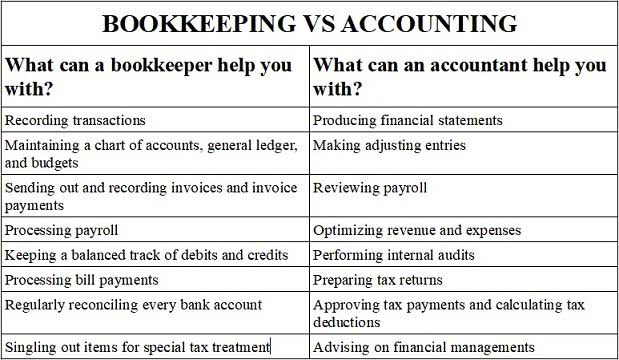
With accurate bookkeeping, you can tell how much your business is making in terms of income and track your spending to ensure that you have enough cash on hand to cover your business expenses. Proper financial records make it easier for you to analyze the financial state of your firm and determine areas that need improvement. The easiest way to do small business bookkeeping is by using accounting software, such as FreshBooks. FreshBooks makes it easy to automate large parts of the bookkeeping example of small business bookkeeping process, simplifying this vital task while ensuring accurate financial reports, tracking, and records. The accrual-based accounting method works better with double-entry bookkeeping, so it’s best for more complex business structures or businesses that keep inventory or sell goods.
Factors affecting the price of accounting software
- Taxes such as income, payroll, or sales tax are crucial for businesses operating in the USA.
- Let’s use the cash flow coverage ratio as an example, which will tell you if you have enough cash to pay off debts in the short term and the long term.
- Though you may not work regularly with a tax specialist year-round, you’ll want to connect with one sooner rather than later so you’re not rushed come tax time.
- You record transactions when the money actually enters or leaves your business, even if they were earned or billed earlier.
- As soon as you see growth in your company, it will soon be essential to have a detailed, consistent bookkeeping approach.
- Spreadsheets, such as Microsoft Excel, can be used for simple bookkeeping.
- Psst—to stay organized and make recording easier, remember to keep your personal finances and your business finances separate.
This financial statement helps prevent that by forecasting when you might face cash shortages or have extra funds to invest in growth. A business bank account is required if you form a business entity like an LLC or corporation. And while it’s optional for a sole proprietorship or partnership, it’s highly recommended. If you’re going to be doing your own bookkeeping, it’s worth talking to a pro when you set up your system to make sure the accounts you create align recording transactions with your industry standards and CPA expectations.
Income and expense tracking

At the end of the accounting period, take the time to make adjustments to your entries. For example, you may have estimated certain invoices that are later solidified with an actual number. Super pumped up about bookkeeping now and looking for something to get started on right away? Your cash flow statement helps you understand how money moves into and out of your business. The assets section of your balance sheet tells you how much value your business has, while the liabilities section tells you how much money you owe. To prepare a profit and loss statement, first include all the revenue your business made during that period.

Accounting ledger
With the help of cloud accounting software for small-business bookkeeping, you can pretty much automate the process. Fortunately, small business owners don’t need to be experts in mathematics to find success when doing their own bookkeeping. There are many ways to divide bookkeeping responsibilities and leverage powerful technology and small business accounting software for more accurate expense tracking. Maintaining bookkeeping tasks is essential for the stability and success of small businesses. With so many moving pieces (including assets and liabilities, and income and expenses), small business owners must stay on top of it all. Another type of accounting method is the accrual-based accounting method.
- Understanding how to calculate Net Present Value is beneficial for your long-term financial planning.
- Debits and credits should always equal each other so that the books are in balance.
- Our team is ready to learn about your business and guide you to the right solution.
- Waiting until crunch time to prepare documents and fix bookkeeping errors can be too late if the records are kept with many mistakes.
- GAAP stands for Generally Accepted Accounting Principles, which are the best methods you can use to track and manage your business financials.
- These are methods used by most people in the accounting profession, so if your bookkeeping is ever questioned, your methods will be accepted by others.
- Just because you do most of your work from your dining room table doesn’t mean that you can deduct your entire monthly rent.
Weeks turn into months, and before you know it, it’s time to file taxes but all you have is a box of unorganized. Under cash accounting, you record transactions only once money has exchanged hands. If you bill a customer today, those dollars don’t enter your ledger until the money hits your bank account. If you need to borrow money from someone other than friends and family, you’ll need to have your books together. Doing so lets you produce financial statements, which are often a prerequisite for getting a business loan, a line of credit from a bank, or seed investment.
Your financial transactions
Maintain a consistent schedule of comparing the budget with actual business health. Make smarter choices for growth and improve your financial picture with this data. A qualified tax professional such as a CPA, EA, or tax attorney can help structure your business for optimal tax treatment and identify deductions you might miss on your own. They can also help you understand how different business decisions affect your tax situation. For example, the timing of major equipment purchases can significantly impact your tax bill, and a CPA can help you plan these decisions strategically.
Step 5: Review your financial statements

Create a cash flow forecast that looks at least six months ahead, and set aside money for taxes with every sale rather than scrambling at deadline time. Single-entry is like keeping a personal checkbook – you record money coming in or going out in a single line. While this might work for very small businesses with simple transactions, double-entry bookkeeping provides a more complete and accurate picture. While cash accounting is simpler, accrual gives you a more accurate picture of your business’s financial health, especially if you deal with inventory or offer credit terms to customers. Try setting aside and scheduling a ‘bookkeeping day’ once a month to stay on top of your financials. Use that day to enter any missing transactions, reconcile bank statements, review your financial statements from the last month and make any major changes to your accounting or bookkeeping.

How software can help with bookkeeping for small businesses
- Since the information gathered in bookkeeping is used by accountants and business owners, it is the basis of all the financial statements generated.
- The balance sheet summarizes your company’s assets, liabilities, and more as of a specific date.
- The best accounting software automates a lot of the process in journal entries for regular debits and credits to help eliminate possible errors in data entry.
- Consider creating a labelled file folder for each of these expense categories.
- It shows your current assets and liabilities, as well as the total sum of your equity and liabilities (such as debt your company owes).
- Historical cost may factor in when you’re accounting for lump-sum purchases.
The way you categorize transactions will depend on your business and industry. Generally speaking, your transactions fall into five account types—assets, liabilities, equity, revenue, and expenses. Individual line items are then broken down into subcategories called accounts. In our ice cream shop example, some accounts in your ledger might be “revenue-ice Interior Design Bookkeeping cream sales”, “expenses-ice cream ingredients”, etc.
